Resources | Term 2 Unit 1 | Geography | 7th Social Science - Exercises Questions with Answers | 7th Social Science : Geography : Term 2 Unit 1 : Resources
Chapter: 7th Social Science : Geography : Term 2 Unit 1 : Resources
Exercises Questions with Answers
Evaluation
I. Choose the correct answer
1. Which one
of the following is renewable resource?
a) old
b) Iro
c) Petrol
d) solar energy
Answer: d) solar energy
2. Where is
the largest solar power project situated in India?
a) Kamuthi
b) Aralvaimozhi
c) Muppandal
d) Neyveli
Answer: a) Kamuthi
3. Which is
one of the first metals known and used by man?
a) Iron
b) copper
c) Gold
d) Silver
Answer: b) copper
4. -------------
is one of the indispensable minerals used in electrical and electronics Industry.
a) Limestone
b) Mica
c) Manganese
d) Silver
Answer: b) Mica
5. Electricity
produced from coal is called---------------
a) Thermal Power
b) Nuclear power
c) Solar power
d) Hydel power
Answer: a) Thermal Power
II. Fill in the blanks
1. China is the largest producer of hydro-electricity.
2. Iron ores found at Kanjamalai in Tamil Nadu.
3. Aluminum is produced from bauxite ore.
4. Manganese is used in making electrical batteries.
5. Petroleum and its derivatives are called Black Gold.
III. Match the following
1. Renewable resource - Iron
2. Metallic resource - Mica
3. Non-metallic resource - Wind energy
4. Fossil fuel - Sedimentary rock
5. Limestone – Petroleum
Answer:
1. Renewable
resource - Wind energy
2. Metallic
resource - Iron
3. Non-metallic
resource - Mica
4. Fossil fuel - Petroleum
5. Limestone - Sedimentary rock
IV. Consider the following statement and tick (✓) the appropriate answer
1. Assertion
(A) :
Wind power is Clean Energy.
Reason (R) : Wind turbines
do not produce any emissions
a. A and R are correct and R explains A
b. A and R are correct but R does not explain A
c. A is incorrect but R is correct
d. Both A and R are incorrect
Answer: a. A and R are correct
and R explains A
2. Assertion
(A)
: Natural gas is found with petroleum deposits.
Reason (R) : It can
be used as a domestic and industrial fuel.
a. A and R are correct and R explains A
b. A and R are correct but R does not explain A
c. A is incorrect but R is correct
d. Both A and R are incorrect
Answer: b. A and R are correct but R
does not explain A
V. Answer the following
1. Define
- Resource.
Anything which can be used for satisfying
the human needs is called resource. Natural resources are resources that exist
without action of humankind.
2. What are
the uses of iron?
Iron is used in engineering
applications, such as the construction of machinery and machine tools,
automobiles, construction of large ships, structural components of building, bridges etc.
3. What are
the major utilizers of solar energy in the world?
India, China, Japan, Italy and
States of America are major utilizers of solar energy in the world.
4. Name the types of coal based on carbon content.
Coal is classified into four types based on carbon content. They
are:
1. Anthracite
2. Bituminous
3. Lignite
4. Peat.
5. Give a
short note on Duralumin.
Duralumin is an alloy of aluminium
with some other metals. It is made up of 90% aluminium 4% copper 1% magnesium
and 1% manganese. As it is a light and hard it is used in aircraft
construction.
VI. Distinguish the following
1. Biotic
resources and abiotic resources

Biotic resources
1) Biotic resources are found in the biosphere which are
obtained from living and organic materials.
2) They include forests, crops, birds, animals, fishes, man and
materials that can be obtained from them.
Fossil fuels such as coal and petroleum are also included in
this category because they are formed from decayed organic matter.
Abiotic resources
1) Abiotic resources are those that come from non-living,
non-organic material.
2) They include land, water, air, sunlight and heavy metals ores
such as gold, iron, copper, silver etc.
2. Renewable
resources and non-renewable resources
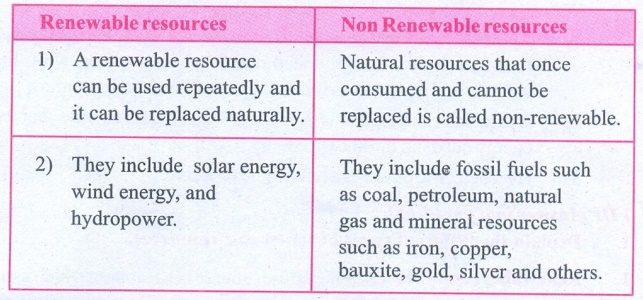
Renewable resources
1) A renewable resource can be used repeatedly and it can be
replaced naturally.
2) They include solar energy, wind energy, and hydropower.
Non Renewable
resources
1) Natural resources that once consumed and cannot be replaced
is called non-renewable.
2) They include fossil fuels such as coal, petroleum, natural
gas and mineral resources such as iron, copper, bauxite, gold, silver and
others.
3. Metallic
resources and non-metallic resources
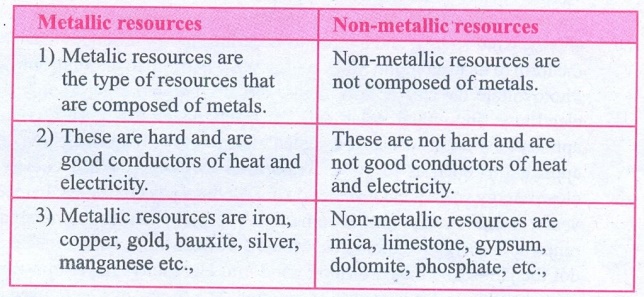
Metallic resources
1) Metalic resources are the type of resources that are composed
of metals.
2) These are hard and are good conductors of heat and
electricity.
3) Metallic resources are iron, copper, gold, bauxite, silver,
manganese etc.,
Non-metallic
resources
1) Non-metallic
resources are not composed of metals.
2) These are not hard and are not good conductors of heat and
electricity.
3) Non-metallic resources are mica, limestone, gypsum, dolomite,
phosphate, etc.,
VII. Give reason
1. Aluminium
has wide range of uses compared to other metals.
Aluminium has wide range of uses compared to other metals.
Because
1) Aluminium is light in weight, tough and cheaper, which makes
it popular metal for constructional purpose.
2) It is mainly used in the construction of aircrafts, ship,
automobiles, railway coaches and etc.
3) Aluminium is a good conductor of electricity and heat, hence,
it is used for making electrical cables.
4) It is highly resistant to corrosion.
2. Water is
considered as a great source of energy.
Water is considered as a great source of energy. Because
1) At present, water is used for producing hydroelectric power.
Hydroelectricity is generated from moving water with high velocity and great
falls with the help of turbines and dynamos.
2) Hydroelectricity power is the cheapest and most versatile
source of energy out of all the known energy.
3) Hydroelectric power is a renewable resource.
VII. Answer in a paragraph
1. Explain
the different types of renewable resources.
1. Renewable
resources : A renewable resource is a resource
which can be used repeatedly and replaced naturally. Renewable resources
harvested and used rationally will not produce pollution. The use of renewable
resources and energy sources is increasing worldwide. Example: solar energy,
wind energy, and hydropower. Solar
energy produces energy in the form of heat and light. Solar energy is not
harmful to the environment. Photovoltaic devices or solar cells, directly
convert solar energy into electricity. Individual solar cell in group panel can
perform small applications from charging calculator, watch batteries, to large
applications such as to power residential dwellings. Wind energy is clean energy since wind turbines do not produce any
emissions. In recent years, wind energy has become one of the most economical
and renewable energy technologies. Modern wind turbines with three blades dot
the landscape today, turning wind into electricity. Hydropower is considered as a great source of energy. At present,
water is used for producing hydroelectric power. Hydroelectricity is generated
from moving water with high velocity and great falls with the help of turbines
and dynamos. Hydroelectricity is the cheapest and most versatile source of
energy out of all the known energy. Hydroelectric power is a renewable
resource.
2. Describe
the non-metallic resources.
Non-metallic resources: Non-metallic
resources can be described as the resources that do not comprise metals. These
are not hard substances, and are not good conductors of heat and electricity.
Examples for non-metallic resources are mica, limestone, gypsum, dolomite,
phosphate, etc. Mica is one of the
indispensable minerals used in electrical and electronics industry. It is used
as an insulating material in electrical industry. In powder form, it is used
for making lubricating oils and decorative wallpapers. Limestone is a sedimentary rock, composed mainly by skeletal
fragments of marine organisms such as coral, foraminifera and molluscs. About
10% of sedimentary rocks are limestones. It is used for facing stone, floor
tiles, stair treads, windows sills and many other purposes. Crushed limestone
is used in smelting and other metal refining process. Portland cement is made
from limestone.
3. What are
the different types of fossil fuel resources? Explain them.
Fossil fuel resources : Fossil fuel
resources are normally formed from the remains of dead plants and animals. They
are often referred to as fossil fuels and are formed from hydrocarbon. When
fossil fuels are burned, they become a great source of heat energy. Examples
for fossil fuel resources are coal, petroleum and natural gas. Coal is the most abundantly found
fossil fuel that forms when dead plant matter is converted into peat. It is
used as a domestic fuel, in industries such as iron and steel, steam engines to
generate electricity. Electricity produced from coal is called Thermal Power.
Coal is classified into four types based on carbon content. They are: 1.
Anthracite, 2. Bituminous, 3. Lignite, 4. Peat. The leading coal producers of
the world is China. Petroleum is
found between the layers of rocks and is drilled from oil fields located in
Offshore and coastal areas. This is sent to refineries which process crude oil
and produce variety of products like diesel, petrol, kerosene, wax, plastics
and lubricants. Petroleum and its derivatives are called Black Gold as they are
very valuable. The leading producers in India are Digboi in Assam, Bombay High
in Mumbai and the deltas of Krishna and Godavari rivers. Natural gas is found with petroleum deposits and is released when
crude oi1 is brought to the surface. It can be used as a domestic and
industrial fuel. In India, Krishna and Godavari Delta, Assam, Gujarat and some
areas of offshore in Mumbai have natural gas resources.
IX. Activity
1. Mark the
metallic resources on the given outline map of the world.
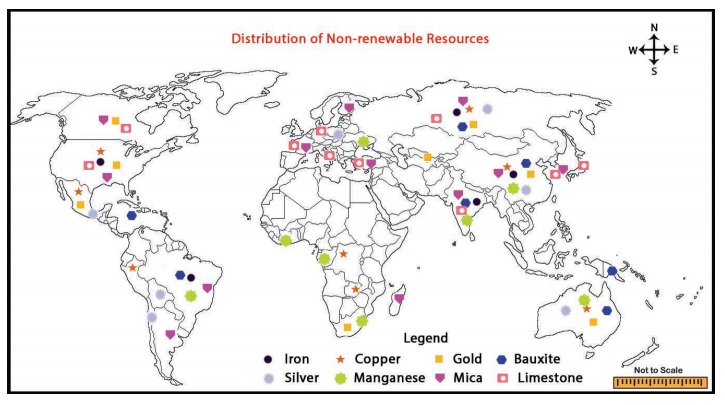
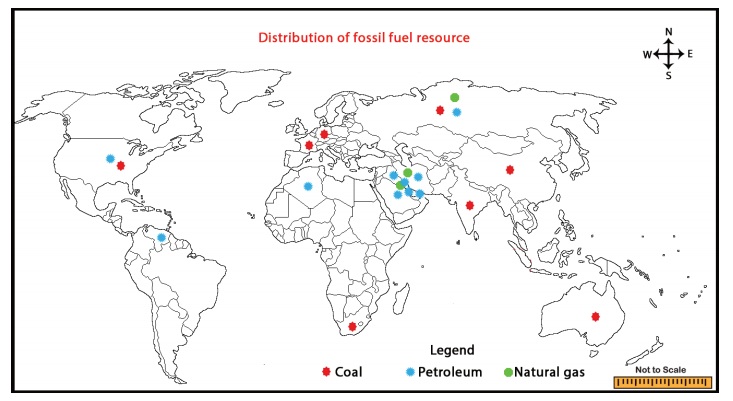
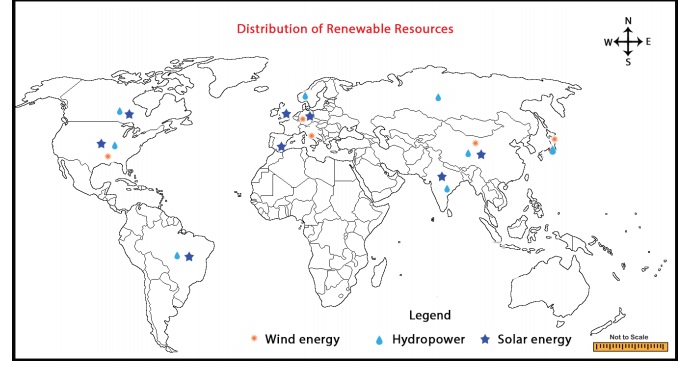
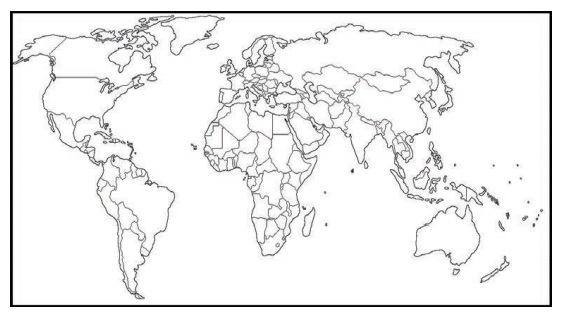
2. Crossword
puzzle

Across
2. The leading
coal producers of the world
4. Considered
as a great source of energy
5. Precious
metal like gold
6. Used as
an insulating material in electrical industry
Down
1. Used in
making electrical batteries
2. Good conductor
of heat and electricity
3. The largest
producer of gold in India
5. Produces
energy in the form of heat and light
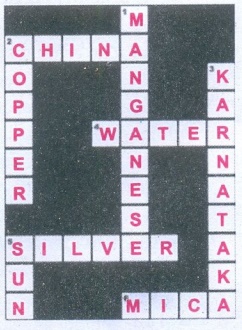
Related Topics